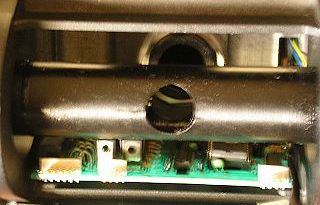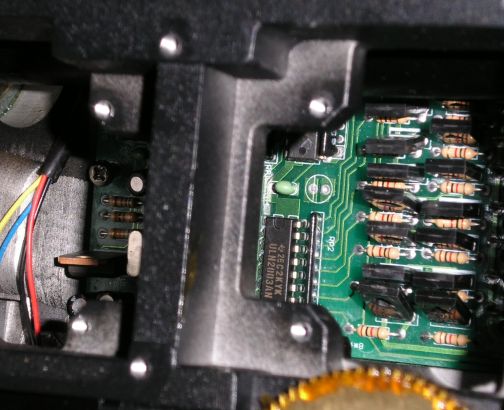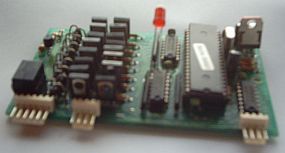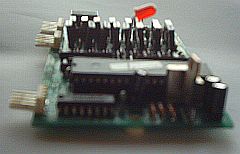
Cables removed, here it is advisable to measure the distance from
the PCB to the center of the aperture in the dec-axis.
The manual of the H-EQ5 equatorial mount reads that under dark conditions, a soft red light shall be used in order to illuminate the reticle. Really not very handy, when fiddling on the tripod, taping on appears not to be a real option. Anyway using a red flashlight on front of the polar scope will not lead to a homogeneous illumination of the reticle.
Fortunately there is very simple solution, all you need is a simple red LED. The electronics of the H-EQ5 is already prepared for an LED. All you need is this LED and a little bit of wire...
The polar scope aims though the declination axis, this is what the bore on the axis is for (have a look). The PCB controlling the motors is just next to it. So, the goal is to have a LED shining into the polar scope, in an ideal case centered to polar scope. Yes, indeed, placing the LED dead center into the light path takes away some of the stars' light, but, this scope is supposed to provide you with a look on Polaris, having a visual magnitude of about 2... for use in the northern hemisphere (as is you would not have known what I meant).

Cables
removed, here it is advisable to measure the distance from
the PCB
to the center of the aperture in the dec-axis.
So far so good, up to now there was not so much to take apart... As I mentioned before, the mount is prepared for this LED by the factory. In any case this means that the PCB has to be taken out. Now it comes, this is only possible after removal of both motors. The following photograph shows the PCB in the mount, with removed motors.

Left
side, in the shadow, but clearly visible, one of the Phillips screws
holding
the PCB into place. In the middle of the PCB the pads for
the LED are
located, even being indicated as such.
Now I guess it is clear why motors have to go out...

PCB
on the bench...
Once taken out the PCB is worked on as on any other electronics project. Proving the thesis that a LED had to be soldered in simply, I did just that.


This setup proved the functionality, but resulted in a very “one-sided” illumination of the reticle. I stopped taking photos, imagine that there is some wire required to lift the LED just a little bit further.
The LED will be lit as soon there is power (12V) provided to the mount. It is glowing quiet dim, I would not expect the LED draining any reasonable power source ,-)
Result? At least I am very pleased with the result, the red light is just bright enough to cause sufficient contrast on the lines of the reticle, without blinding out Polaris. I guess that a super-bright LED could be to bright...
Last modified Feb. 12th 2005